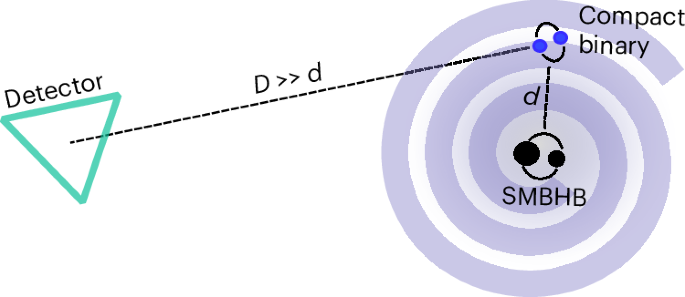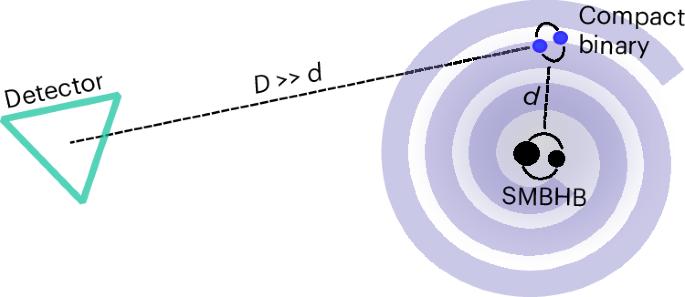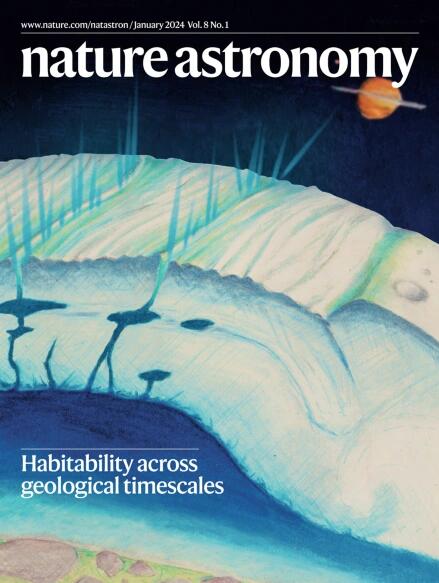大质量黑洞双星对邻近十赫兹引力波源的影响
IF 12.9
1区 物理与天体物理
Q1 ASTRONOMY & ASTROPHYSICS
引用次数: 0
摘要
宇宙中质量最大的黑洞会在合并星系的中心形成双星。最近脉冲星定时产生的引力波(GW)背景证据可能是首次观测到这些超大质量黑洞双星(SMBHBs)合并。然而,质量最大的超大质量黑洞无法被干涉引力波探测器探测到,也很难通过脉冲星定时单独分辨出来。这些局限性要求我们采取尚未探索的策略,在未知频段≲10-5 Hz探测单个SMBHB,以确定它们的丰度,并解读它们与宿主星系的共同演化。在这里,我们展示了 SMBHB 对来自同一星系中距离 d ≲ 1 kpc 的恒星质量双星的 GW 的可探测的长期调制。我们认为,拟议中的对众多恒星质量双星敏感的分赫兹全球暖化干涉仪可以发现来自质量约为O(107-108) M⊙的SMBHB的调制,其红移z≈3.5。这为我们提供了一个独特的机会来绘制宇宙时间中的 SMBHBs 群体图,否则我们可能无法获得这些数据。本文章由计算机程序翻译,如有差异,请以英文原文为准。


Imprints of massive black-hole binaries on neighbouring decihertz gravitational-wave sources
The most massive black holes in our Universe form binaries at the centre of merging galaxies. The recent evidence for a gravitational-wave (GW) background from pulsar timing may constitute the first observation that these supermassive black-hole binaries (SMBHBs) merge. Yet, the most massive SMBHBs are out of reach of interferometric GW detectors and are exceedingly difficult to resolve individually with pulsar timing. These limitations call for unexplored strategies to detect individual SMBHBs in the uncharted frequency band ≲10−5 Hz to establish their abundance and decipher the coevolution with their host galaxies. Here we show that SMBHBs imprint detectable long-term modulations on GWs from stellar-mass binaries residing in the same galaxy at a distance d ≲ 1 kpc. We determine that proposed decihertz GW interferometers sensitive to numerous stellar-mass binaries could uncover modulations from ~O(10−1–104) SMBHBs with masses ~O(107–108) M⊙out to redshift z ≈ 3.5. This offers a unique opportunity to map the population of SMBHBs through cosmic time, which might remain inaccessible otherwise. Merging supermassive black holes emit low-frequency gravitational waves, difficult to observe with current and future detectors. Stegmann et al. show that these black holes can leave measurable traces in high-frequency signals from adjacent sources.
求助全文
通过发布文献求助,成功后即可免费获取论文全文。
去求助
来源期刊

Nature Astronomy
Physics and Astronomy-Astronomy and Astrophysics
CiteScore
19.50
自引率
2.80%
发文量
252
期刊介绍:
Nature Astronomy, the oldest science, has played a significant role in the history of Nature. Throughout the years, pioneering discoveries such as the first quasar, exoplanet, and understanding of spiral nebulae have been reported in the journal. With the introduction of Nature Astronomy, the field now receives expanded coverage, welcoming research in astronomy, astrophysics, and planetary science. The primary objective is to encourage closer collaboration among researchers in these related areas.
Similar to other journals under the Nature brand, Nature Astronomy boasts a devoted team of professional editors, ensuring fairness and rigorous peer-review processes. The journal maintains high standards in copy-editing and production, ensuring timely publication and editorial independence.
In addition to original research, Nature Astronomy publishes a wide range of content, including Comments, Reviews, News and Views, Features, and Correspondence. This diverse collection covers various disciplines within astronomy and includes contributions from a diverse range of voices.
 求助内容:
求助内容: 应助结果提醒方式:
应助结果提醒方式:


